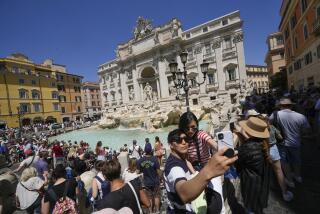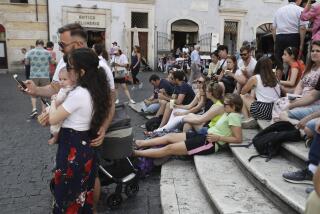Take the Travel Plunge
- Share via
As you look through your window you can see that the leaves are beginning to bud on your fruitless mulberry tree and the devil grass is showing some green. Spring is just around the corner and summer vacation is just a few calendar pages away.
It’s Sunday morning, and sitting over a cup of coffee you look over the Travel section. You’ve saved some money and your charge card is paid up, so with a clear conscience your thoughts have turned to vacation.
Where should you go this year? Will it be the beach or the mountains again? Or should you visit those relatives in Cleveland? Somehow, these ideas don’t make your pulse leap.
As you idly turn the pages an ad catches your eye: “Middle Europe Highlights--10 Days.” Then others: “London Theater Tour,” “Greece and the Aegean,” “Spain and Portugal by Bus,” “Grand Tour of France.” Your adrenaline reaches your itchy foot. Could you? Should you?
Of course you can. You’re not getting any younger. Why shouldn’t this be the year for that long-hoped-for trip to Europe?
So you let your imagination run rampant. You’ve always wanted to go to Europe. You love history, romantic castles, the Arc de Triomphe, the Tower of London, museums, theater, the fiords. Even a pinch on the tush seems more continental than objectionable.
OK, so it’s possible. But to make it more than another Sunday morning daydream, what do you do next? It can’t be that difficult, you reason, millions have done it.
So let’s begin at the beginning. There are three things that obviously have to mesh if you’re going to make this thing work properly. How much time, how much money and where in the wide world should you go? Of these, the most important, probably, is the money. So you get out the computer.
Aid of a Travel Agent
With a rough figure in mind, the next step should be a visit to your travel agent. If you don’t have one, ask around among friends. Check the classified section of your phone book or call the American Society of Travel Agents for suggestions.
Remember that in most cases the use of a travel agent doesn’t cost you a dime. They make their money from the hotels, airlines, ship lines, etc., that you select. They can provide information on these facilities, often based on firsthand knowledge, along with a raft of colorful brochures with prices on hotels, cruises and tour packages.
Just let them know how much money you think you can afford, how much time you can spend and some ideas on where you would like to go, and they will provide you with suggestions and material to help you make a decision. When you’re ready, they will make the necessary hotel, airline or package reservations.
Generally, a package deal is best for a first-time trip. For the timid, it provides companionship with other English-speaking travelers, some insulation against culture shock and a long umbilical cord to home. In addition, it affords a broad overview of your destination, ideally with an informed tour guide, and assures that you will see as much as possible in a given time.
Don’t let the price of a package overwhelm you. The total may seem high, but if you divide it by the number of days on the tour, you’ll find it easier to live with the expense. Checking the ads recently, I found tour packages for as little as $65 a day. This was for a 15-day European capitals tour for $970. There also was a nine-day tour of England for $777, or about $85 a day.
And these figures included the air fare. They also included most meals, land transportation, admission charges to tourist attractions, tipping and luggage handling. How much do you think this would cost in Cleveland if you stayed in a comparable hotel and had to pay extra for food, transportation and et ceteras-- plus your air fare?
Price Discrepancies
Of course, many European packages run a lot more, from $100 to $150 a day, and some of them don’t include air fare.
This is an area where a good travel agent can be of help in selecting the right tour. He or she can point out some of the reasons for the price discrepancies--differences in accommodations, tour stops, etc.--and help you decide which one suits you best.
If you are considering a do-it-yourself tour--renting a car, making hotel reservations, figuring out time and distances, buying airline tickets, etc.--remember that it takes a lot of moxie, a lot of careful planning, a lot of luck and lots and lots of time. Mistakes, bad advice and misjudgment could turn that dream vacation into a disaster.
Take advantage of a trained travel planner’s know-how and after you have returned from your first trip--and have become more aware of the many details involved--decide whether you are ready, or willing, to do it yourself the next time.
If, in spite of these cautions, you are determined to try it on your own, aim for the off-seasons when travel is lighter and there is more leeway for error.
For those who are young and hardy and on a tight budget, a camping or hosteling trip is worth looking into. They, too, are a learning experience but also can be less traumatic with an organized package.
Selecting an Area
Whether you decide to concentrate on a specific area or gulp all of Western Europe in one bite is another major decision. Selecting a specific area can present a problem because most of us have a lengthy list of places we have wanted to go for one reason or another--a setting of a favorite novel or movie, a desire to dig up our roots, a love of history or the arts--and narrowing it down can be difficult.
The second option, the multiple-country tour, usually is based on the distressing possibility that you may never be able to make another trip, so you’d better see all you can. It’s a realistic concern, so if you have enough time and money, go for it.
But in doing so, try to avoid the wearisome “If It’s Tuesday . . . “ syndrome of a different city and a different hotel room every day. Look for a tour that affords an opportunity to do some things on your own and gives you time to digest what you’re seeing.
If time is an inflexible factor in your plans, tell your travel agent one, two, three weeks. More? One week is cutting it pretty thin, but keep in mind that most European countries are smaller than many of our states and there usually is a selection of rail, bus or cruise packages of eight days to chose from.
For the independent traveler, there is time in a one-week vacation for a few days of concentrated sightseeing in London, Paris or Rome, for instance, plus several side trips to explore the environs. These can give you a fairly comprehensive look at the cities plus a tantalizing glimpse of the rest of the country.
Two or three weeks are better, and your options expand proportionately. There are eight- and 10-day packages that fit nicely into a two-week vacation and many allow extensions at the beginning or end. Most European tour packages are for 10 days to three weeks, with a sprinkling of “grand” tours of four and five weeks.
Decision Time
After reading brochures and books, talking to your travel agent and friends and trying to balance time and money, you should have arrived at a decision.
Once you have decided on where to go, contact the tourist office of the country or countries you’re going to visit (addresses are elsewhere in this issue of the Travel section). This is how you fine-tune your travel. They can give you specific information on what to see in your free time; what to wear; facts on currency, weather and shopping.
They are especially helpful to the do-it-yourselfer, providing information on what to see, where to stay and the how-to.
They, along with your travel agent, also have information on passports, visas and possible health requirements.
The public library and bookstores are other sources of information. Doing your homework is part of the fun, and knowing something of the geography, history and cultures of places you will be visiting guarantees that you will get more for your money.
Now, having laid the groundwork, take courage in hand and head for your travel agent, plunk down your deposit and relax. The hard part is over.
More to Read
Sign up for The Wild
We’ll help you find the best places to hike, bike and run, as well as the perfect silent spots for meditation and yoga.
You may occasionally receive promotional content from the Los Angeles Times.






